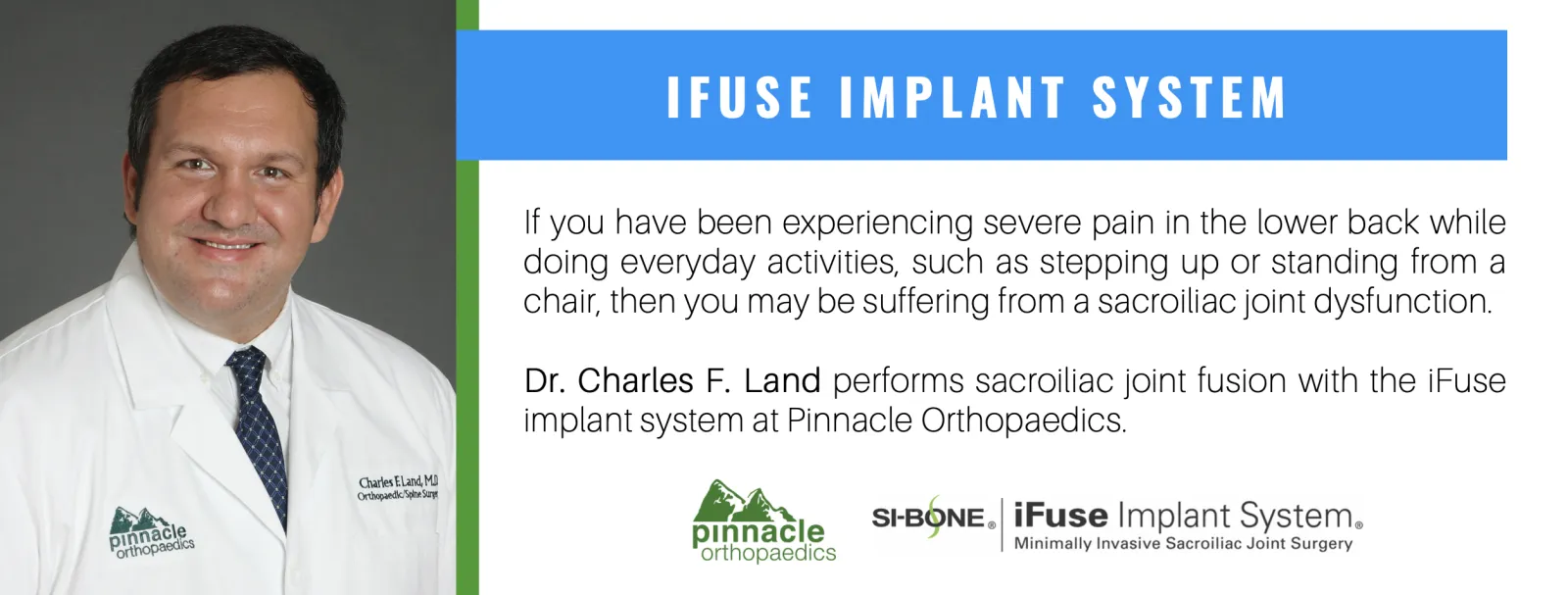Sacroiliac Joint Fusion with the iFuse Implant System
A sharp pain in the lower back, which can sometimes travel through the buttocks, thighs, and groin, can indicate a lot of things. One possible cause is sacroiliac joint dysfunction. In fact, studies suggest that 15% to 30% of lower back pain cases are due to a problem or dysfunction in the sacroiliac joint.
The sacroiliac joint can be found in the pelvic region between the iliac bones (wings of the pelvic area) and sacrum (tail end of the spine). Its main job is to connect the spine to the hips, thus providing stability by absorbing impact and distributing the body's weight during motion.
Pain in the SI joint can be caused by an injury or bone joint degeneration. Initially, orthopedic specialists treat this condition using non-surgical options, such as oral medications, injection therapy, and physical therapy.
When these conservative methods fail, they can then perform a surgical operation called sacroiliac joint fusion with the iFuse implant system.
What are SI joint fusion and iFuse Implant System?
Traditionally, doctors perform a sacroiliac joint fusion to treat persistent lower back pain caused by SI joint dysfunction. It involves fusing the sacrum to the ilium through bone grafting and implanting rods and screws in the area to achieve fusion.
Ideally, fusion surgery can significantly help in reducing SI joint pain and inflammation by preventing too much mobility and establishing stability in the area. However, not every lumbar fusion surgery results in pain relief. According to studies, 43% of patients still experience lower back pain after undergoing fusion surgery.
Fortunately, an SI joint fusion done using the iFuse implant system lowers the risk of continuing back pain after a sacroiliac joint surgery. Here's how it works:
The titanium rods used in an iFuse system contain a triangular cross-section to prevent it from rotating once implanted.
The implants have a titanium plasma spray coat that allows them to have a rough surface, thus securing them firmly in the bone.
The implants have a high-level rigidity that allows them to hold the joint in place, thus preventing instability.
As a result, patients with an iFuse implant demonstrated a significant reduction in lower back pain after the procedure. Furthermore, studies have also reported that patients experienced an improved physical function and enhanced quality of life after the iFuse procedure.
How is the iFuse implant procedure done?
The iFuse Implant System involves fusing the sacrum to the ilium using three triangular-shaped titanium implants in the SI joint. This minimally invasive procedure allows further joint stability, thus eliminating pain and improving overall function. Here's a step-by-step procedure on how an orthopedic surgeon performs an SI bone iFuse Implant System.
First, you will be put under general or spinal anesthesia to keep you relaxed and comfortable during the whole procedure.
Since it's only minimally invasive, the procedure only requires a small, inch-long incision to be made along the side of your buttocks.
Guided by a fluoroscope, your surgeon will then use a set of special instruments to facilitate the placement of three small titanium implants into the sacroiliac joint.
Once everything is in place, they will withdraw the instruments, seal the cut, and place you in a recovery room.
Unlike the traditional open surgery, this procedure only lasts for about an hour. Your orthopedic specialist can discharge you the next day, depending on how well your body recovers.
At discharge, you will be given a set of post-operative instructions on how to take care of yourself during recovery. This may include activity modifications, crutches for about six weeks, and post-operative check-up schedules.
What are the benefits of an iFuse Implant System?
Both the traditional SI joint fusion surgery and iFuse Implant System can treat sacroiliac joint dysfunction and degeneration. However, the iFuse procedure demonstrates superior durable effectiveness against traditional fusion surgery. Some of the benefits of opting for an iFuse implant include the following:
Minimally invasive procedure
No tissue stripping and little to no tendon irritation.
Quicker recovery time
Immediate post-surgical stabilization
Effective in reducing or eliminating lower back pain due to SI joint problems.
SI Bone iFuse Implant System at Pinnacle Orthopaedics
Have you been experiencing severe pain in the lower back while doing everyday activities, like stepping up or standing from a chair? If so, then you may be suffering from a sacroiliac joint dysfunction.
Problems in the SI joint can be treated using different methodsä¸from chiropractic therapy to anti-inflammatory medications. If you have exhausted all kinds of conservative treatment options and still suffer from this kind of pain, then it's time to try the iFuse Implant System at Pinnacle Orthopaedics.
Our orthopedic specialists and surgeons at Pinnacle are specifically trained in the latest minimally invasive surgical techniques, including the iFuse procedure. Our board-certified doctors are passionate about providing you with the quality care and service you deserve.
Do you want to know if you're a good candidate for the iFuse Implant System? Make an appointment now by visiting one of our five convenient locations near you:
We also provide other innovative orthopedic treatment options, such as the BEAR Implant and the ROSA robotic knee replacement. Contact us today to learn more!

The material contained on this site is for informational purposes only and DOES NOT CONSTITUTE THE PROVIDING OF MEDICAL ADVICE, and is not intended to be a substitute for independent professional medical judgment, advice, diagnosis, or treatment. Always seek the advice of your physician or other qualified healthcare providers with any questions or concerns you may have regarding your health.
